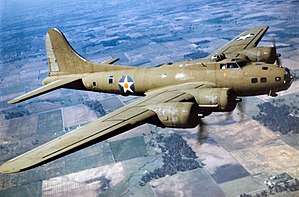396th Bombardment Group
The 396th Bombardment Group is a former United States Army Air Forces unit. It was active during World War II as a Boeing B-17 Flying Fortress operational training unit, training newly organized units, then as a replacement training unit for aircrews. It was inactivated in 1944 in a general reorganization of Army Air Forces training units..
| 396th Bombardment Group | |
|---|---|
 B-17 as used by the 396th Group for training | |
| Active | 1943–1944 |
| Country | United States |
| Branch | United States Army Air Forces |
| Role | heavy bomber training |
History
The 396th Bombardment Group was activated at Mountain Home Army Air Field, Idaho on 16 February 1943 with the 592d, 593d, 594th and 595th Bombardment Squadrons assigned.[1][2][3][4] After initial organization and equipping with Boeing B-17 Flying Fortress heavy bombers, the group moved to Moses Lake Army Air Base, Washington. There the 396th acted as an Operational Training Unit (OTU) for B-17 units. The OTU program involved the use of an oversized parent unit to provide cadres to "satellite groups"[5] In August 1943, the unit's mission changed to being a Replacement Training Unit (RTU).[1] Like OTUs, RTUs were oversized units. Their mission, however was to train individual pilots or aircrews.[5]
In November 1943, the 396th moved to Drew Field, Florida, where it would remain for the duration of its active service.[1] However, the Army Air Forces was finding that standard military units, based on relatively inflexible tables of organization were not well adapted to the training mission. Accordingly, it adopted a more functional system in which each base was organized into a separate numbered unit.[6] The 592d was inactivated on 1 May 1944 at Drew Field, Florida.[1] Its personnel and equipment became part of the 326th AAF Base Unit.[7]
Lineage
- Constituted as the 396th Bombardment Group (Heavy) on 29 January 1943
- Activated on 16 February 1943.
- Inactivated on 1 May 1944[1]
Assignments
- II Bomber Command, 16 February 1943
- Second Air Force, 6 October 1943
- III Bomber Command, 5 November 1943 – 1 May 1944
Components
Stations
- Mountain Home Army Air Field, Idaho, 16 February 1943
- Moses Lake Army Air Base, Washington, 10 April 1943
- Drew Field, Florida, 5 November 1943 – 1 May 1944[1]
Aircraft
- Boeing B-17 Flying Fortress, 1943-1944[1]
Campaign
| Campaign Streamer | Campaign | Dates | Notes |
|---|---|---|---|
| American Theater without inscription | 19 January 1943 – 1 May 1944 | [1] |
References
Notes
- Maurer, Combat Units, p. 283
- Maurer, Combat Squadrons, p. 676
- Maurer, Combat Squadrons, pp. 676-677
- Maurer, Combat Squadrons, p. 677
- Craven & Cate, Introduction, p. xxxvi
- Goss, p. 75
- See Mueller, p. 351 (simultaneous inactivation of 396th Bombardment Group units and organization of 326th Base Unit).
Bibliography
![]()
- Craven, Wesley F; Cate, James L, eds. (1955). The Army Air Forces in World War II (PDF). Vol. VI, Men & Planes. Chicago, IL: University of Chicago Press. LCCN 48003657. OCLC 704158. Retrieved 17 December 2016.
- Goss, William A. (1955). "The Organization and its Responsibilities, Chapter 2 The AAF". In Craven, Wesley F; Cate, James L. (eds.). The Army Air Forces in World War II (PDF). Vol. VI, Men & Planes. Chicago, IL: University of Chicago Press. LCCN 48003657. OCLC 704158. Retrieved 17 December 2016.
- Maurer, Maurer, ed. (1983) [1961]. Air Force Combat Units of World War II (PDF) (reprint ed.). Washington, DC: Office of Air Force History. ISBN 0-912799-02-1. LCCN 61060979. Retrieved 17 December 2016.
- Maurer, Maurer, ed. (1982) [1969]. Combat Squadrons of the Air Force, World War II (PDF) (reprint ed.). Washington, DC: Office of Air Force History. ISBN 0-405-12194-6. LCCN 70605402. OCLC 72556. Retrieved 17 December 2016.
- Mueller, Robert (1989). Air Force Bases, Vol. I, Active Air Force Bases Within the United States of America on 17 September 1982 (PDF). Washington, DC: Office of Air Force History. ISBN 0-912799-53-6. Retrieved 17 December 2016.

.svg.png)